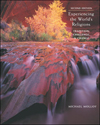 |
1 |  | 
"Stupa" refers to the community of monks and nuns; lowercased, this term refers to an individual monastic community. |
|  | A) | True |
|  | B) | False |
 |
 |
2 |  | 
"Tathata" means 'thatness,' 'thusness,' 'suchness'; the uniqueness of each changing moment. |
|  | A) | True |
|  | B) | False |
 |
 |
3 |  | 
"Samadhi" is a state of deep awareness, the result of intensive meditation. |
|  | A) | True |
|  | B) | False |
 |
 |
4 |  | 
"Anatta" means 'No self'; the doctrine that there is no soul or permanent essence in people and things. |
|  | A) | True |
|  | B) | False |
 |
 |
5 |  | 
In Zen, "anichcha" refers to the enlightened awareness. |
|  | A) | True |
|  | B) | False |
 |
 |
6 |  | 
"Lama" means 'Meditation'; focusing of the mind; sometimes, stages of trance. |
|  | A) | True |
|  | B) | False |
 |
 |
7 |  | 
In Zen Buddhism, a "koan" is a question that cannot be answered logically; a technique used to test consciousness and bring awakening. |
|  | A) | True |
|  | B) | False |
 |
 |
8 |  | 
"Vajra" is a symbolic hand gesture. |
|  | A) | True |
|  | B) | False |
 |
 |
9 |  | 
"Guanyin" is the term that means the release from suffering and rebirth that brings inner peace. |
|  | A) | True |
|  | B) | False |
 |
 |
10 |  | 
"Dharma" refers to the totality of Buddhist teaching. |
|  | A) | True |
|  | B) | False |
 |
 |
11 |  | 
A "lama" is a Tibetan Buddhist teacher, often a monk. |
|  | A) | True |
|  | B) | False |
 |
 |
12 |  | 
"Samsara" refers to the constant rebirth and the attendant suffering; the everyday world of change. |
|  | A) | True |
|  | B) | False |
 |
 |
13 |  | 
"Dhyana" means impermanence, constant change. |
|  | A) | True |
|  | B) | False |
 |
 |
14 |  | 
"Mudra" means the three 'baskets,' or collections, of Buddhist texts. |
|  | A) | True |
|  | B) | False |
 |
 |
15 |  | 
"Satori" is a circular design containing deities, geometrical forms, symbols, and so on that represent the totality, the self, or the universe. |
|  | A) | True |
|  | B) | False |
 |
 |
16 |  | 
"Dukkha" is a popular bodhisattva of compassion in Mahayana. |
|  | A) | True |
|  | B) | False |
 |
 |
17 |  | 
"Koan" means 'Enlightenment being'; in Mahayana, a person of deep compassion, especially one who does not enter nirvana but is constantly reborn to help others; a heavenly being of compassion. |
|  | A) | True |
|  | B) | False |
 |
 |
18 |  | 
"Dukkha" means sorrow, misery, suffering. |
|  | A) | True |
|  | B) | False |
 |
 |
19 |  | 
"Tripitaka" is the Buddha of the Western Paradise, a biss-body Buddha in Mahayana. |
|  | A) | True |
|  | B) | False |
 |
 |
20 |  | 
"Bodhi" means enlightenment. |
|  | A) | True |
|  | B) | False |
 |
 |
21 |  | 
"Mudra" is the 'diamond' scepter used in Tibetan and other types of Buddhist ritual, symbolizing compassion. |
|  | A) | True |
|  | B) | False |
 |
 |
22 |  | 
"Shunyata" means compassion, empathy. |
|  | A) | True |
|  | B) | False |
 |
 |
23 |  | 
"Maitreya" is Buddha (or bodhisattva) expected to appear on earth in the future. |
|  | A) | True |
|  | B) | False |
 |
 |
24 |  | 
A "stupa" is a shrine, usually in the shape of a dome, used to mark Buddhist relics or sacred sites. |
|  | A) | True |
|  | B) | False |
 |
 |
25 |  | 
In Theravada, a "sutra" is a person who has practiced monastic disciplines and reached nirvana, the ideal. |
|  | A) | True |
|  | B) | False |
 |
 |
26 |  | 
"Trikaya" refers to the three 'bodies' of the Buddha—the cosmic Buddha nature, the celestial Buddhas, and the historical Buddhas. |
|  | A) | True |
|  | B) | False |
 |
 |
27 |  | 
A "sutra" is a sacred text, especially one said to record the words of the Buddha. |
|  | A) | True |
|  | B) | False |
 |
 |
28 |  | 
"Shunyata" is the Mahayana notion of emptiness, meaning that the universe is empty of permanent reality. |
|  | A) | True |
|  | B) | False |
 |



 2002 McGraw-Hill Higher Education
2002 McGraw-Hill Higher Education

 2002 McGraw-Hill Higher Education
2002 McGraw-Hill Higher Education